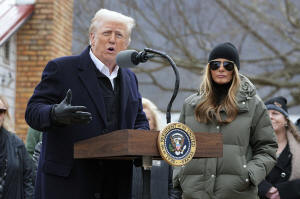5 economic forces that could shape the first year of Trump's presidency
 Send a link to a friend
Send a link to a friend
 [January 25, 2025] By
JOSH BOAK [January 25, 2025] By
JOSH BOAK
WASHINGTON (AP) — Like most presidents, Donald Trump faces an economy
that seldom bends to political ambitions.
The Republican has promised strong growth, high tariffs, income tax cuts
and booming oilfields. But despite the solid job market and low 4.1%
unemployment rate, he has to contend with headwinds like inflation, a
budget deficit, increased tensions over trade, the fallout from his
plans to curtail immigration and a persistent wealth gap.
Each of these issues could help to shape how voters feel about a
president they returned to the White House with the specific goal of
fixing the economy.
For his part, Trump wants to blame all the challenges before him on his
predecessor, Joe Biden, who in turn blamed Trump in 2021 for the
problems his own administration had to tackle.
“This begins with confronting the economic chaos caused by the failed
policies of the last administration,” Trump told the World Economic
Forum on Thursday.
Here are five economic forces that could shape the first year of Trump's
presidency:
For voters, the price still isn't right
Whipping inflation is easier said than done.
In AP VoteCast, an extensive survey of last year's electorate, 4 in 10
voters called inflation the “single most important factor” in their
choice for president. About two-thirds of this group voted for Trump — a
sign he owes his victory in large part to the high cost of groceries,
gasoline, housing, autos and other goods.

Going forward, monthly reports on the consumer price index will be a
clear measure of whether Trump can deliver. But inflation has actually
increased in recent months. Consumer prices were increasing at a healthy
2.4% annual rate in September, compared with 2.9% in December.
Economists say inflation could worsen if Trump imposes tariffs and uses
deficit-funded income tax cuts.
Republicans often hit Biden hard on egg prices. But Democrats could use
similar attacks on Trump. Over the past year, coffee costs have risen
just 1% for U.S. consumers, but the International Monetary Fund has the
price of the actual beans climbing 55% in a sign that lattes, espressos
and plain old cups of joe could soon cost more.
Then there's housing. Voters are still frustrated by high mortgage rates
and prices staying elevated due to a shortage of properties. Shelter is
37% of the consumer price index. Price increases for housing have eased,
but shelter costs are still rising at 4.6% a year, compared with annual
increases averaging 3.3% before the pandemic.
Trump is betting that more energy production can cut into inflation
rates, but domestic production is already near record levels, according
to the government.
Which tariffs are really coming
Trump says 25% tariffs are coming for Mexican and Canadian imports as
soon as Feb. 1. He's also talked about additional tariffs of 10% on
Chinese goods. His stated goal is to stop illegal border crossings and
the flow of chemicals used to make drugs such as fentanyl.
For Trump, tariffs are a diplomatic tool for his policy goals. But
they're also a threat possibly meant to jumpstart trade talks. They're
also a revenue raiser that he claims could bring trillions of dollars
into the treasury.
Trump did increase tariffs during his first term, with revenue
collection more than doubling to an annual rate of $85.4 billion, which
might sound like a lot but was equal to just 0.4% of the gross domestic
product. Multiple analyses by the Budget Lab at Yale and the Peterson
Institute for International Economics, among others, say the threatened
tariffs would increase costs for a typical family in a way that
effectively raises taxes.
What really matters is whether Trump delivers on his threats. That is
why Ben Harris, a former Biden adviser who is now director of economic
studies at the Brookings Institution, says voters should focus on
average tariff rates.

“Trade is really tricky" Harris said. “But in broad terms, look at what
he does and not what he says.”
[to top of second column] |

President Donald Trump, along side first lady Melania Trump, speaks
as he meets with homeowners affected by Hurricane Helene in
Swannanoa, N.C., Friday, Jan. 24, 2025. (AP Photo/Mark Schiefelbein)
 What happens with the national
debt
Trump likes to blame inflation on the national debt, saying Biden's
policies flooded the U.S. economy with more money than it could
absorb. But about 22% of the $36 trillion outstanding total debt
originated from the policies of Trump's first term, according to the
Committee for a Responsible Federal Budget, a fiscal watchdog.
Paul Winfree, a former Trump staffer who is now president and CEO of
the Economic Policy Innovation Center, warned in a recent analysis
that the U.S. is getting too close for comfort to its fiscal limits.
His analysis suggests that if Trump can preserve 3% growth he could
extend his expiring 2017 tax cuts while keeping the debt
sufficiently stable by cutting spending $100 billion to $140 billion
a year.
The risk is that higher borrowing costs and debt can limit what
Trump does while keeping borrowing costs high for consumers.
Lawmakers who once viewed the debt as problem years away
increasingly see it as something to address now.
“One of the biggest vibe shifts I'm picking up on now among
policymakers is they’re beginning to realize the long-term is
today,” Winfree said.
Winfree said the key number to watch is the interest rates charged
on U.S. debt — which will tell the public if investors think the
amount of borrowing is problematic. Interest on the 10-year U.S.
Treasury note is at roughly 4.6%, up a full percentage point since
September.
Immigrants are still needed to fill jobs
Trump's executive orders are a clear crackdown on immigration — and
that could be a drag on economic growth and cause monthly job gains
to slow. Trump often frames immigration as a criminal and national
security issue by focusing on people crossing the border illegally.
But economies that can't add enough workers are at risk of
stagnating — and the U.S. labor market at this stage needs
immigrants as part of the jobs mix. About 84% of America's net
population growth last year came from immigrants, according to the
Census Bureau. That's 2.8 million immigrants.

“They not only work in the economy, but they spend in the economy,”
said Satyam Panday, chief U.S. economist at S&P Global Ratings.
"Their spending is somebody else’s income in the economy.”
If Trump were simply to put immigration back at his 2017 and 2019
averages of 750,000 immigrants annually, growth could slow from an
estimated 2.7% last year to 2% going forward, Panday's analysis
found. The construction, agriculture and leisure and hospitality
industries would probably struggle to find employees.
In other words, it's worth monitoring the monthly jobs report and
immigration flows.
Mind the wealth gap
Trump is going to have to figure out how to balance the interests of
billionaires with those of his blue- collar voters. His inaugural
events included several of the world's wealthiest men: Tesla's Elon
Musk, Amazon's Jeff Bezos, Meta's Mark Zuckerberg and LVMH's Bernard
Arnault. Each is worth roughly $200 billion or more, according to
the Bloomberg Billionaire's Index.
Scott Ellis, a member of the group Patriotic Millionaires, said it's
worth monitoring just how much their wealth increases under Trump.
This year, as of Friday, Arnault’s net worth has risen $23 billion,
Bezos is up by $15 billion, Zuckerberg is up by $18 billion and
Musk’s wealth has risen by $6 billion. Those are all monthly
increases.
By contrast, the most recent available Census Bureau data show that
the median U.S. household wealth rose $9,600 in 2021-2022, to
$176,500.
All contents © copyright 2025 Associated Press. All rights reserved |